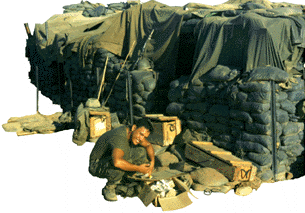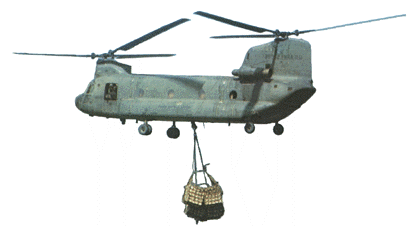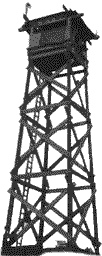
As homes go, Patrol Base Dragon was not
much to boast about, unless you wanted to define a new standard of squalor. Dirt
floors, dirt walls, dirt yards - set off with traditional olive-drab accents
everywhere. Instead of a quaint white picket fence we had double rows of Concertina
wire - though it lacked charm it excelled at keeping the neighborhood kids out. Claymore mines backed it up. Our kitchen was a portable
propane stove and Dragon featured open air dining everyday. On the cook's day off
there were always "C" rations, sort of like going out for fast food where the
hamburgers were cooked twenty years ago. No, this was nobody's idea of a dream
house. But then, we didn't really take much time decorating it.
Our departure from Patton followed sacred Army tradition - we weren't told about it
until it was time to grab our gear and go. They gave us fifteen minutes to get our
packs and form up on the chopper pad. I stuffed my shaving gear and letter pad into
the pack, and shouldered my radio, rifle and ammo bag. After four hard weeks of
filling sandbags and building big, roomy bunkers at Patton, we were now abandoning them to
who knows what unworthy outfit...
Rumors flew as usual. Maybe our month of hard work would be rewarded with a
stand-down, two days of relaxation and entertainment back at Cu Chi. Or perhaps we
were finally off to the "Bridge", which legend said was outfitted with decent
accommodations. Or maybe, as a worst case possibility, we were going to the Ho Bo
Woods, home base of the enemy.
We boarded the Chinook quickly and the big ramp lifted behind us. The powerful
rotors pulled and the machine lifted off the ground, tilted forward and began its climb.
Patton II receded and we sped past the green rice paddies. Tiny villages,
clusters of hootches, farmers in their fields plowing with buffalo - gradually they too
were left behind. Our flight was taking us east and north, away from our Division
HQ. Wherever we were headed, it was not to Cu Chi for a stand-down. We did not
rule out the Bridge yet, but the possibility seemed more and more remote.
We were at two or three thousand feet now, and the landscape - what we could see of it
from the small windows - had become more dense and less hospitable. Not a good sign!
Then the roar of the engines lessened a few degrees, and we could feel the craft
descend. The rotors slowed to an idle and the large back ramp dropped down.
One by one we filed down and stared around us.
There was no doubt about it - the worst case possibility was now a reality. We
were in the Ho Bo Woods.
 As soon as our Chinook lifted away, several more came in. Huge cargo
nets dangled beneath them carrying pallets with bundles of sandbags (where had we seen
this before?), shovels, rolls of concertina, ammo - all the usual stuff. Another
Chinook appeared with a small bulldozer hanging beneath it. As soon as the dozer was
unhooked, the Chinook landed a crew to assemble and operate it. Soon they were
piling dirt into a rough circular wall. Unlike the wall at Patton, this one was low
- no more than three feet tall. Very strange!
As soon as our Chinook lifted away, several more came in. Huge cargo
nets dangled beneath them carrying pallets with bundles of sandbags (where had we seen
this before?), shovels, rolls of concertina, ammo - all the usual stuff. Another
Chinook appeared with a small bulldozer hanging beneath it. As soon as the dozer was
unhooked, the Chinook landed a crew to assemble and operate it. Soon they were
piling dirt into a rough circular wall. Unlike the wall at Patton, this one was low
- no more than three feet tall. Very strange!
Of course we didn't get to stand around and watch. We were here to work.
Our company split into platoons and headed off on patrol. The new base would command
a large plateau. We were building in a wide grassy clearing, perhaps half a mile in
diameter. Beyond lay patches of thick brush and forest. On two sides of the
plateau, the ground sloped gently down to slow-moving streams that were more like swamps
in some places. The sides were overgrown with tall trees. The soil varied from
sand to loam - in some places patches of sand with a sort of beach grass predominated,
while in others a rich growth of plants and shrubs indicated deep humus soil.
We walked south toward a patch of trees in the distance, where we would turn and sweep
around to the west. After checking that area, we were to turn back toward the camp
and return about mid-afternoon. Each patrol would thus complete a quarter circle.
Even though aerial photo reconnaissance had checked things out, nothing beat a
firsthand look from the ground.
By 10:00 we had reached the tree line. It was not yet solid forest, but scattered
clumps of thin trees separated by little parks of grass and bush. We moved down into
one of these clearings, careful to keep our distance from one another. As our point
man reached the edge of the grass, a booby trap exploded beneath him, throwing him back
onto the ground. We went to our knees, rifles at the ready, selector switches
flipped to full automatic. But there was no shooting, no enemy fire.
Cautiously, the next man in line moved forward to check the point. He had taken
shrapnel wounds in his foot, leg and side. We bandaged him
and made him as comfortable as we could. I forwarded our situation to the new
headquarters on the plateau while another RTO called for a
Medevac. Within minutes the Medevac came in. Some of us covered the tree line
and the evacuation as others got the wounded man aboard. This was a bad beginning.
If you believed in omens, you could say this was a sign that we didn't really want
to be living in this kind of a neighborhood.
We resumed our patrol. We marched without further incident around the edge of the
trees and back across the meadow towards our new base. And at 3:30 P.M., right on
schedule, we arrived "home". What a difference! The empty plain had
been gouged up into wall segments. Every eight or ten feet, holes had been left in
the three-foot wall so we could build bunkers. Another company had been lifted in
while we were gone, and they had already started building theirs. Of course, they
left plenty for us. They wouldn't think of depriving us of the enjoyment of
constructing our own!
 A twenty foot tower dominated the center of the compound. Back-to-back
at its base sat two 105 mm howitzers. These cannons fired a three-inch diameter
shell of high explosive. Each was mounted on a flat swivel base, so the gun could
rotate in any direction; each would provide cover to 180 degrees of the perimeter.
The muzzles sat about four feet off the ground. Now the reason for the low walls
became apparent. The guns were meant to fire over them pointblank. Our targets
were expected at that height and that close to the guns. In other words, we were
setting up for a ground attack. One might even say inviting it! I started
thinking about the possibilities of requesting a transfer . . .
A twenty foot tower dominated the center of the compound. Back-to-back
at its base sat two 105 mm howitzers. These cannons fired a three-inch diameter
shell of high explosive. Each was mounted on a flat swivel base, so the gun could
rotate in any direction; each would provide cover to 180 degrees of the perimeter.
The muzzles sat about four feet off the ground. Now the reason for the low walls
became apparent. The guns were meant to fire over them pointblank. Our targets
were expected at that height and that close to the guns. In other words, we were
setting up for a ground attack. One might even say inviting it! I started
thinking about the possibilities of requesting a transfer . . .
One half of the perimeter was nearly complete. We went to work on our bunkers.
We dug three foot deep holes and erected sandbag walls on the ground outside.
We roofed them with sheets of metal and several more layers of bags for protection
against mortars. Each bunker had two forward-facing slits through which to fire.
At the rear was the entrance, with steps dug into the dirt.
Several command bunkers were already completed in the center of the circle close to the
tower. There were bunkers for the gun crews, the cooks, and the communications crew.
Compared to ours, these were mansions! Each was constructed mostly
underground, with dirt steps down to the living area. Their floors were covered with
empty wooden shell boxes. A generator near the tower provided light and powered the
radar unit up in the tower.
We took time out from sandbagging for supper. Our cook had arrived earlier and
fixed up his "kitchen". We were treated to a hot meal, and returned to our
work with new energy. And by dark we were finished. The outer berm was now
complete, and the circle had been closed. Outside the wall, the other company had
worked through the late afternoon stringing one thin circular strand of Concertina wire
around the base. In the morning we would finish the job. Now we placed Claymore mines twenty feet in front of the bunkers, ran the wires
through our gun ports and fastened them inside.
This was Dragon and how it came to be. A patrol base gouged in one day out of the
soil of the peaceful-looking meadows where we had landed that morning and which we would
leave just as quickly four weeks later. It was not elegant, but it was functional.
That night, in the last few minutes of daylight, I wrote my daily letter to Sue.
I wrote about the ride over that morning, the layout of the terrain, the pretty sky that
bid us good evening, and the features of our new camp. I omitted the accident on
patrol, as I had so many others, to keep her from worrying. I told myself then that
I would never want to remember most things that happened in Vietnam - the ugly things, the
unpleasant things, the death and suffering visited upon us and the people of the
countryside. But I have never stopped remembering, looking back. The weeks
ahead would add many more such memories. Our platoon came to Dragon at nearly full
strength; when we left there were only 17 of us.
It was not the anticipated ground attack that decimated us - Dragon never drew that
battle. No, the enemy never came to us. So, instead, we went to him. Day
after day we patrolled, and day after day the booby traps took their toll. Flak jackets became mandatory apparel. Every moment at Dragon
would be filled with anxiety, day and night, as we waited for the
assault, not knowing when or even if it would come. It was as if a weight hung over
us, held by a thread that could break any second. At Dragon, fear and danger were
always with us.
